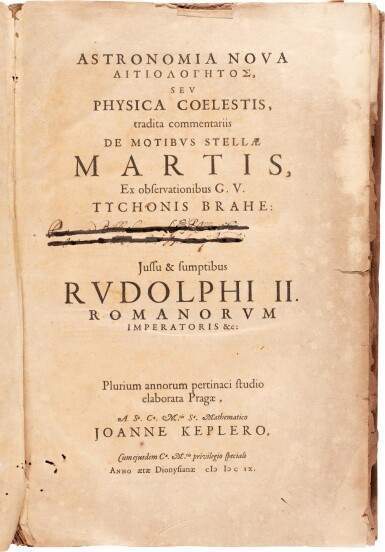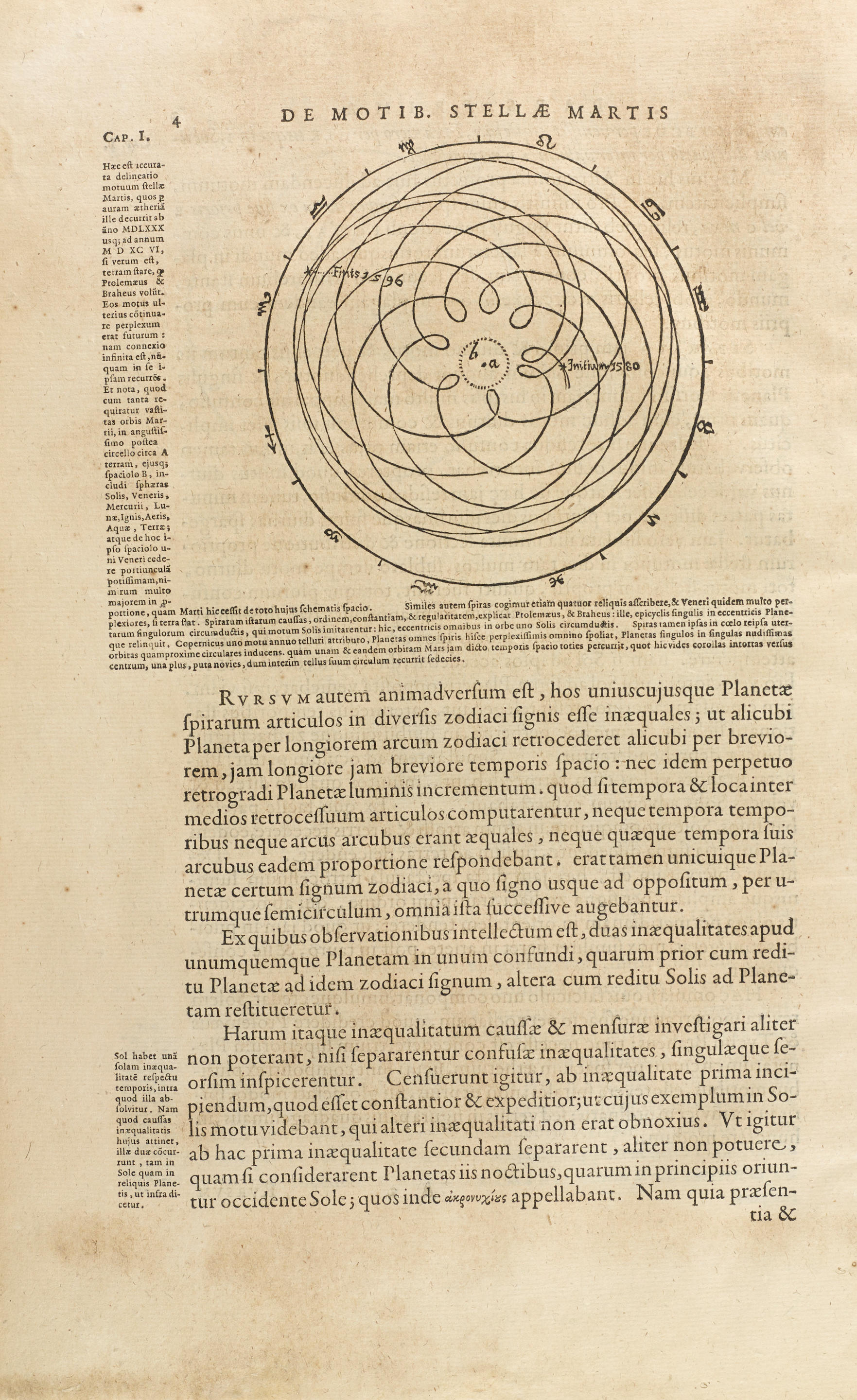Kepler, Johannes Astronomia nova αιτιολογητος, seu physica coelestis, tradita commentariis de motibus stellae Martis, ex observationibus G.V. Tychonis Brahe. [Heidelberg: Gotthard Vögelin], 1609 folio (388 x 250mm.), blank leaf before title, folding letterpress table, woodcut initials, head- and tailpieces, woodcut diagrams, with final blank, disbound, mostly heavily browned, O6 and P1 with some loss of text, T1 torn without loss, a few wormholes in gutter (sometimes touching text) FIRST EDITION of Kepler's masterpiece of modern astronomy, boldy entitled The New Astronomy. "Eines des grössten Meisterwerke der Naturwissenschaften aller Zeiten!" (Caspar, p.53). Kepler describes his first two laws of planetary motion, in which the orbits of planets are shown to be elliptic rather than circular, demonstrated by his calculations of the orbit of Mars, and the law of equal areas, which shows that the planets move faster when they are closer to the sun. Its influence on other great astronomers, from his contemporary Galileo to the later Newton, was substantial and enabled Newton to form his own laws of motion and universal gravitation. Kepler's and Newton's laws became the basis of celestial mechanics. Kepler, a student of the "cautious Copernican" Michael Maestlin in Tübingen, used Copernicus's theory of heliocentrism as the basis for his treatise, and combined it with the observational accuracy of Tycho Brahe, whose calculations he acquired through his post as imperial mathematician to Rudolf II, following Tycho's death in Prague in 1601. Disagreement with Tycho's heirs led to delays with the publication which only commenced in the summer of 1608, once Tycho's son-in-law, Franz Tengnagel, was able to add a note to the reader regarding Kepler's deviance from Tycho's calculations. The publication was supposed to be distributed privately by the Emperor, but Kepler sold some copies to the printer in an attempt to recoup some of his salary, which was in arrears. LITERATURE: Caspar 31; Norman 1206; PMM 112; VD17 23:000587W; Zinner 4237 PROVENANCE: "Pertinet ad Bibliothecam [--]", obscured inscription on title-page
Kepler, Johannes Astronomia nova αιτιολογητος, seu physica coelestis, tradita commentariis de motibus stellae Martis, ex observationibus G.V. Tychonis Brahe. [Heidelberg: Gotthard Vögelin], 1609 folio (388 x 250mm.), blank leaf before title, folding letterpress table, woodcut initials, head- and tailpieces, woodcut diagrams, with final blank, disbound, mostly heavily browned, O6 and P1 with some loss of text, T1 torn without loss, a few wormholes in gutter (sometimes touching text) FIRST EDITION of Kepler's masterpiece of modern astronomy, boldy entitled The New Astronomy. "Eines des grössten Meisterwerke der Naturwissenschaften aller Zeiten!" (Caspar, p.53). Kepler describes his first two laws of planetary motion, in which the orbits of planets are shown to be elliptic rather than circular, demonstrated by his calculations of the orbit of Mars, and the law of equal areas, which shows that the planets move faster when they are closer to the sun. Its influence on other great astronomers, from his contemporary Galileo to the later Newton, was substantial and enabled Newton to form his own laws of motion and universal gravitation. Kepler's and Newton's laws became the basis of celestial mechanics. Kepler, a student of the "cautious Copernican" Michael Maestlin in Tübingen, used Copernicus's theory of heliocentrism as the basis for his treatise, and combined it with the observational accuracy of Tycho Brahe, whose calculations he acquired through his post as imperial mathematician to Rudolf II, following Tycho's death in Prague in 1601. Disagreement with Tycho's heirs led to delays with the publication which only commenced in the summer of 1608, once Tycho's son-in-law, Franz Tengnagel, was able to add a note to the reader regarding Kepler's deviance from Tycho's calculations. The publication was supposed to be distributed privately by the Emperor, but Kepler sold some copies to the printer in an attempt to recoup some of his salary, which was in arrears. LITERATURE: Caspar 31; Norman 1206; PMM 112; VD17 23:000587W; Zinner 4237 PROVENANCE: "Pertinet ad Bibliothecam [--]", obscured inscription on title-page




.jpg)


.jpg)
.jpg)
.jpg)


Testen Sie LotSearch und seine Premium-Features 7 Tage - ohne Kosten!
Lassen Sie sich automatisch über neue Objekte in kommenden Auktionen benachrichtigen.
Suchauftrag anlegen